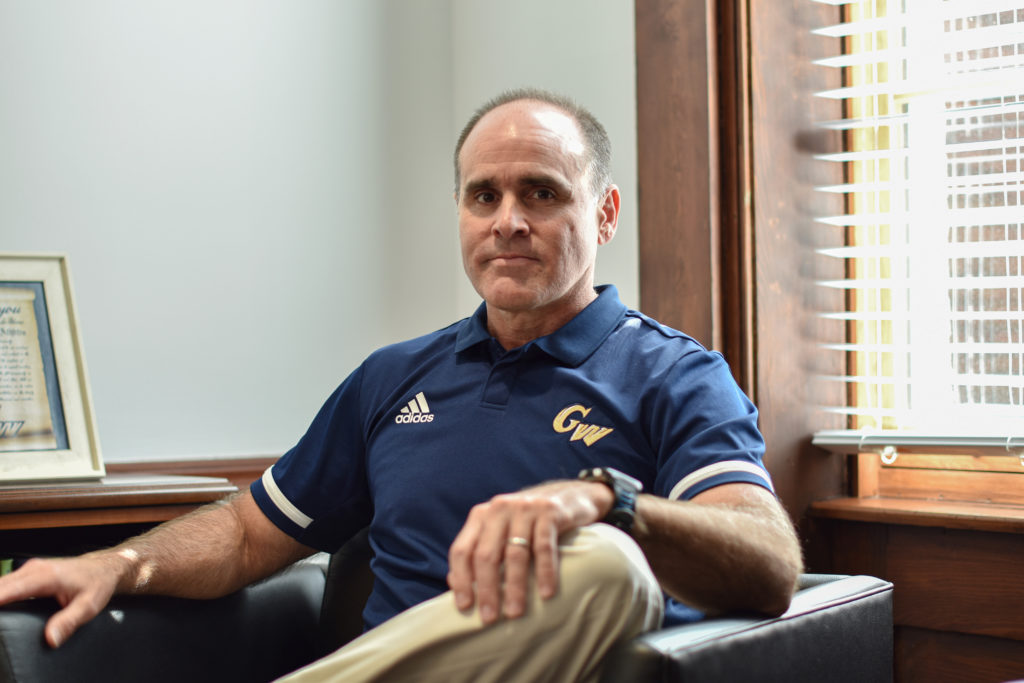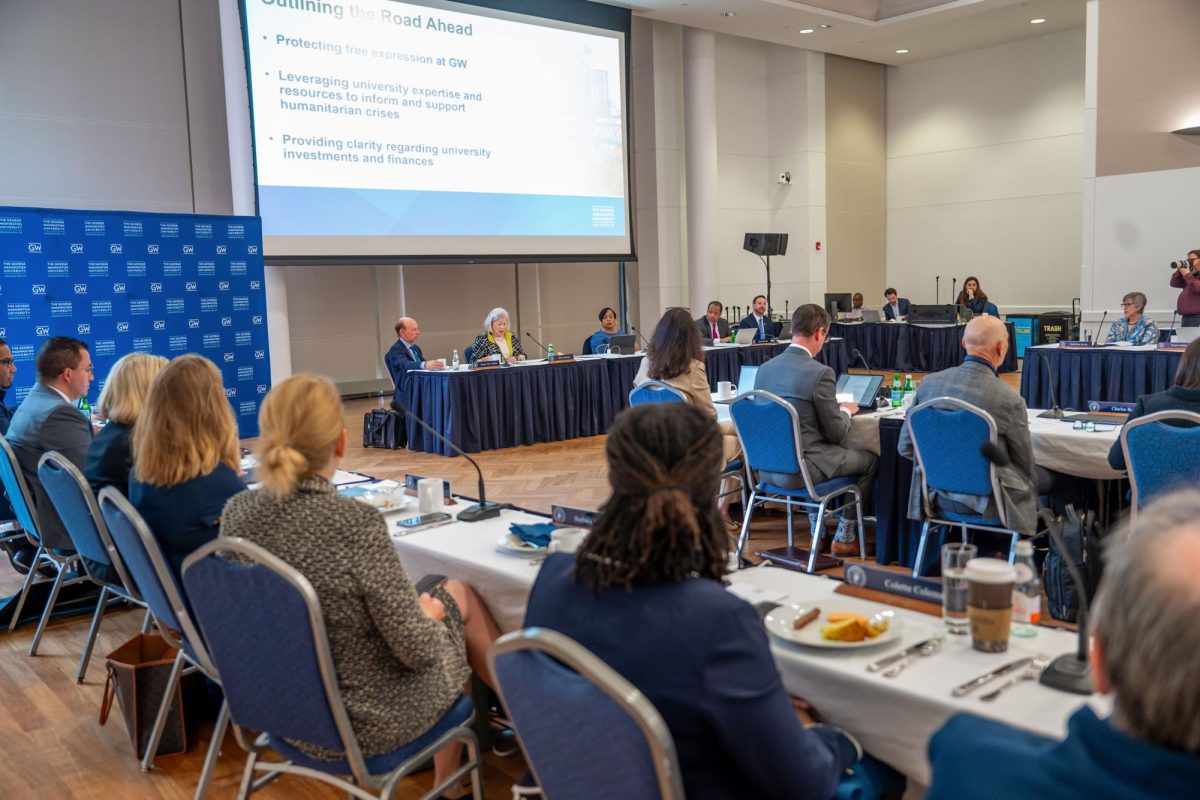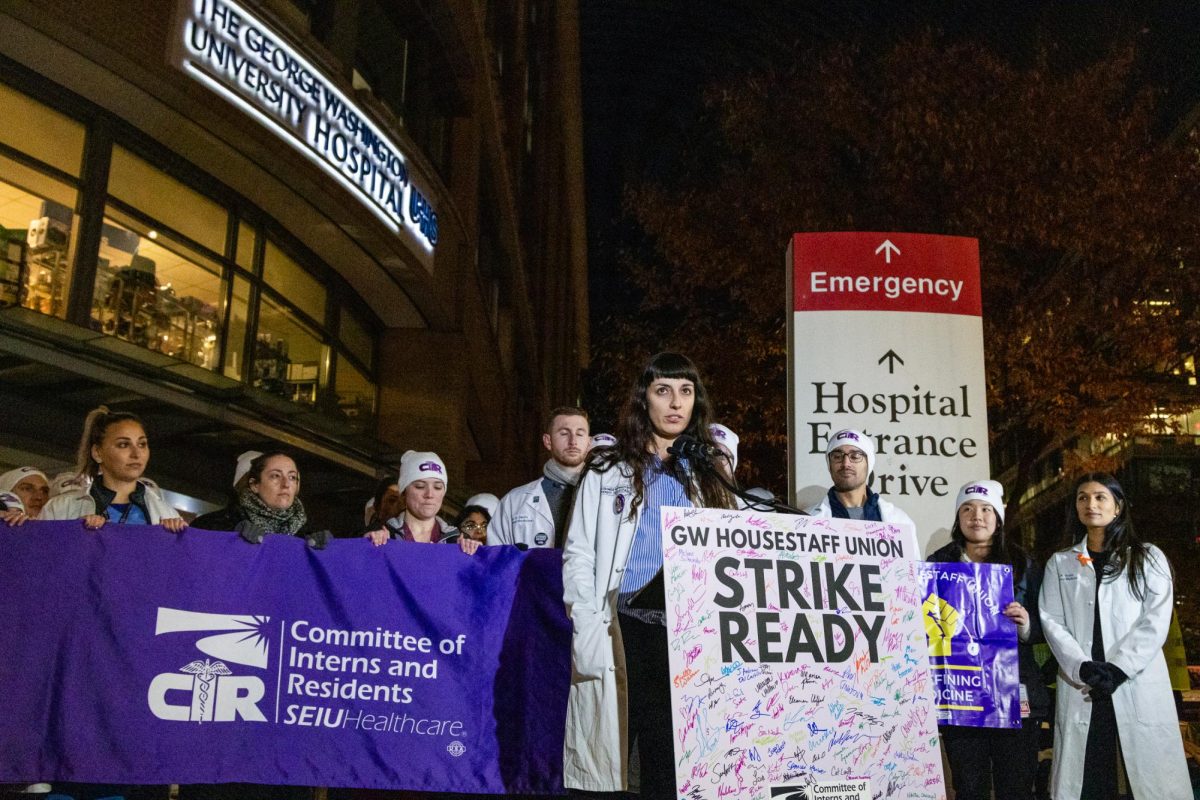Former Chief Financial Officer Mark Diaz has left GW after a tenure filled with efforts to alter the University landscape that often brought ire from the GW community.
Diaz, who as of June 30 is now GW’s former executive vice president and chief financial officer, came to GW in August 2018. Diaz was intimately involved in an array of initiatives like repairs to buildings and residence halls, consolidating IT, hiring new officials and leading GW through the woes of the COVID-19 pandemic.
Diaz – who did not return a request for a final interview with The Hatchet – came to the job following the appointment of University President Thomas LeBlanc, who he had served under as a budget and planning officer at the University of Miami. Since departing the University on June 30, here is the history of his time while at GW.
2018-2019 academic year
Diaz kicked off his first year at GW with a series of in-depth tours of GW’s Foggy Bottom and Mount Vernon campuses, observing several instances of broken down physical infrastructure that required immediate repairs, like a sewage overflow in the University’s psychology department.
Within his first year, Diaz secured $10 million from the Board of Trustees to make “immediate” repairs and “enhancements” across the University to more than 40 buildings and outdoor spaces new flooring in Mitchell Hall and Potomac House and “enhanced” exterior lighting on the Vern.
Diaz also sought to shake up GW’s financial and administrative structure, hiring a slate of new officials focused on areas like tax compliance, employee compensation, and accounting within his first five months on the job. He also created the position of “chief people officer” in April 2019, who would head the University’s human resources and would report directly to him, to “rebrand” some of the University’s leadership.
In January 2019, he launched a new Office of Ethics, Compliance and Privacy, which reviews many of GW’s risk management and conflict of interest policies.
In his first few months, Diaz, LeBlanc and other administrators restructured the University’s relationship with the Medical Faculty Associates, granting officials the authority to appoint new board members and requiring University approval for its annual budget, but also gave the board “substantial autonomy” to operate on its own.
“We couldn’t see a preeminent medical school without high performing physicians – an academic physician practice group,” he said in a February 2018 interview.
2019-2020 academic year
Diaz continued his work within the academic medical enterprise in his second year by announcing in October 2019 that the University would forgive a $20 million loan extended to the MFA three years earlier.
In January 2020, Diaz came under criticism from faculty over a plan to cut undergraduate enrollment, with some faculty senators saying it would force GW to take on more debt to make up for lost revenue.
The University administration faced backlash for LeBlanc’s controversial 20/30 plan – which called for a rough 20 percent cut in enrollment while upping the share of STEM majors by 30 percent.
However, Diaz’s role as chief executive officer was soon overshadowed by the emergence of the COVID-19 pandemic and the industry-wide economic strains that came with it, especially after officials suspended all in-person classes and closed most residence halls in March 2020.
Later that month, Diaz said the GW would halt most of its capital projects and stop hiring new employees, marking the University’s first major belt-tightening policies in response to the financial pressure of the pandemic.
At the end of the academic year, faculty and other community members met the beginning of the budget cuts with concern, over concerns that the University would begin laying off employees, which they said should be left as a matter of “last resort.”
In May 2020, officials announced that most senior officials – including Diaz – would receive salary cuts and freeze all employee salaries.
At the end of the summer, Diaz also slashed dozens of jobs in GW’s information technology office, including its chief officer and put the division under his direct oversight.
2020-2021 academic year
As COVID-19 cases continued to mar the District and facing a seemingly virtual school year, officials were faced with a $180 million budget gap and an estimated 7.2 percent decline in enrollment. Over the next few months, Diaz and other officials would lay off 339 staff at the University by the end of 2020 and temporarily halt base and matching contributions to employee retirement plans.
In September 2020, Faculty Senators passed a resolution calling on officials to maintain salary increases for promoted faculty.
But later that year in the midst of the pandemic, Moody’s Investor Service and Standard and Poors Global Ratings showed confidence in GW to meet its financial obligations.
At the same time, officials rendered the administration’s 20/30 plan was “obsolete” due to financial pressures brought on by the pandemic.
While the COVID-19 pandemic was still raging on, more administrative responsibility fell under Diaz’s purview as the University’s chief technology officer quit two months into his role and Diaz’s office consolidated much of GWIT’s oversight as part of University-wide budget cuts.
At the beginning of 2021, Diaz and other officials began to loosen some of the budget restrictions they had installed at the height of the pandemic, reinstating merit-based salary increases and base retirement contributions in January. In March, officials allowed for matching retirement fund contributions.
In April, a survey of the GW faculty found that faculty members had an “overwhelmingly negative” view of University leadership, with Diaz being mentioned by participants in 62 comments on the survey in a negative or critical light.
Later that month the proposal of the Fiscal Year 2022 budget brought Diaz back in disagreement with faculty leaders, who said the plan didn’t allocate enough resources to research, especially considering many of the delays and decreased funding that took place during the height of the pandemic.
Joe Cordes – the chair of the faculty senate fiscal planning and budgeting – voiced concerns over the size of GW’s $25 million surplus, which they said was in place mostly to appear financially stable for bond rating agencies, especially considering the high demand for increased research funding.
As classes wrapped up and students moved into the summer, LeBlanc announced that he would retire from GW at the end of the 2021-2022 academic year, which he later rebuffed.
2021-2022 academic year
As the long-term leadership and strategic vision of GW remained unclear, Diaz continued to unwind the last of the COVID-19-era budget restrictions, finally eliminating the University-wide hiring freeze in July 2021.
Throughout the next academic year, Diaz would be involved in a number of campus initiatives, including a new $22 million plan to renovate University buildings and increase security measures in December 2021 and spearheading a project to enroll GW students in the U-Pass program, allowing students to have unlimited Metro access throughout the academic year for a flat fee.
LeBlanc left GW in December 2021, leaving former Washington University in St. Louis Chancellor Mark Wrighton as the interim university president for a maximum term of 18 months.
In February, Diaz faced criticism again from faculty leaders over his alleged involvement in a University project that tracked student, faculty and staff movements across campus through the University WiFi system. Faculty leaders said the fact that GWIT and the Office of Ethics, Compliance and Privacy both fell under Diaz’s authority may have made it difficult for the project to have been caught or potentially stopped.
At the end of the academic year, Board of Trustees Chair Grace Speights announced Diaz would be leaving his position by the end of June. After Diaz’s departure Wrighton moved many of the University’s divisions – including GWIT and parts of human resources – out from under the CFO to the Office of the Provost.
Treasurer and Vice President Bruno Fernandes stepped into Diaz’s position as CFO earlier this month. In a restructuring of the CFO’s office, many of Diaz’s other former areas of responsibility, including managing communications and additional administrative areas, have been divided up by a string of new administrators, as officials look to shake up some parts of the University administration.








